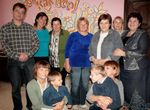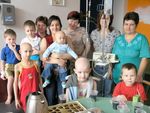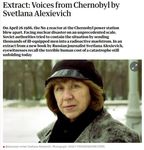Women and Chernobyl - Chernobyl Children's Project
←
→
Page content transcription
If your browser does not render page correctly, please read the page content below
Women and Chernobyl
Three great women writers have done so much to tell the story of Chernobyl. Not the accident
itself, but its impact on the people of Belarus and Ukraine.
Alla Yaroshinskaya
When reactor No 4 at the Chernobyl Nuclear Power Plant blew up in
the early hours of 26th April 1986 it threw millions of curies of
radioactive materials into the air, forming a 2km high plume.
Amongst the most dangerous isotopes it realised were iodine 131,
caesium 137 and strontium 90.
But according to Alla Yaroshinskaya, a
journalist whose tenacity was responsible for
revealing much of the subsequent cover up,
the most dangerous substance to escape from the mouth of the reactor did
not appear on the periodic table. It was Lie-86 a lie as global as the disaster
itself.
She visited towns and
villages in northern
Ukraine 18 months after the accident. The head
of the local department of child health told her
that they had not found any problems linked to
radiation, or any thyroid problems. She had just
visited doctors who told her that 80% of the
children in their district had thyroid problems.
On land contaminated to less than 15 curies
sq/km agriculture continued as normal. The
land in the UK from which farmers could not
sell their lambs was contaminated to less than 1
hundredth of this level.
People who continued to live on contaminated
land were given extra money for food
and free medical care and better
pensions. Sometimes called the ‘coffin
allowance’ Villagers in Ukraine signed
an undertaking not to drink milk from
their cows, but they were not provided
with any clean milk or meat.
In the early years many people
believed that land outside the 30 km
exclusion zone was safe. In 1989
Pravda issued a map showing that
there were some areas of heavy
contamination up to 300 kms from the
plant.The Government in Moscow claimed it was weeks or even months before they fully understood
the extent of the disaster. But Alla Yaroshinskaya was able to reveal that this was not true.
When children were allowed to spend all day
out in the streets for the May Day parade, party
bosses knew that the radiation levels were very
high.
Yaroshinskaya’s newspaper would not publish
her stories but eventually she managed to get
them accepted and people were so impressed
with her struggle to show the true effects of the
disaster, that she was overwhelmingly elected to
the supreme Soviet in 1989. This gave her
greater access to official papers.
The committee headed by Gorbachev, which was dealing with the accident and its aftermath
issued many secret protocols.
Protocol number 9, issued less than three weeks after the accident, dealt with radiation levels,
adopting new levels which can be tolerated by the population ten times higher than before, and in
some cases 50 times higher. ‘Thus we can ensure the continued health of people of all ages, even
if the ambient level of radioactivity stays the same for two and a half years.
Protocol 32 was about the distribution of
contaminated meat. The Ministry of health ordered
that it should be distributed as widely as possible and
made into sausages and pies. There was a similar one
covering milk.
When this factory in Rogachev was found to be
producing contaminated milk, they simply changed the
labels on the cans so no one knew where the yoghourt
or sour cream milk had come from.
Svetlana Alexeivich won the Nobel Prize for
Literature in 2015 for her powerful and moving
oral histories of war and tragedy in Russia.
She interviewed hundreds of people who had
been affected by Chernobyl – soldiers,
firefighters, doctors, scientists, people who had
been evacuated, and people who had stayed in
the contaminated areas. Some of the most
memorable testimony became her book
.’Voices from Chernobyl’ later re-published as
‘A Chernobyl Prayer’
Many of her interviews were used to frame the
story of the Chernobyl series on HBO. The most
powerful and distressing story was Ludmilla
Ignatenko the wife of a fireman whose body
was disintegrating before her eyes in a Moscow Hospital.The first great stress for families, was being evacuated. In many cases they were told they would be back in a few days or weeks, but then were never allowed back. Many Belarusians had lived in the same village all their lives and their parents and grandparents were buried there. It was very hard to leave their land and be consigned to high rise flats in the cities. In some villages they were allowed back, just one day a year, to remember their departed relatives. But other villages no longer existed. During the second world war, the Nazis destroyed 619 Belarussian villages, along with their inhabitants. As a result of fallout from Chernobyl, the country lost 485 villages and settlements. 70 of them have been buried underground by clean-up teams of liquidators. The nuclear industry likes to blame many of the illnesses found in Belarus and Ukraine on the stresses of evacuation and on radiophobia. But this is cruel nonsense. Certainly mothers were under great stress trying to make sure their children had clean food if they still lived in contaminated areas, and if they had been evacuated, worrying about their children being
bullied at school, their husbands being unable to get jobs and their parents greaving every day for
the homes they had lost.
For many mothers there was soon a lot more
to worry about as their children fell ill,
initially with thyroid cancer or leukaemia.
It is usually the mothers who spend many
months in hospital with their child, seeing
them suffer and wondering if they are going
to make it through the treatment.
This is why we invite mums with their young
children as soon as possible after the treatment has
finished to give them both a boost.
There was a very significant rise in the numbers of
children born with disabilities in the months after
the accident. 80% rise in Gomel region, despite a
huge number of abortions and miscarriages.
Whenever a child was born with any obvious
problem doctors would tell the mother that they
should leave him or her in the hospital. He would
probably die and if not he would be well looked
after in an orphanage. They should go home and get
on with their lives. Whenever a mother decided not
to do that, but to keep her child, in the majority of
cases the father would leave.
Fifteen years ago we produced a book about Ira. She had been abandoned as a baby and was
growing up at Zhuravichi. When Ira was interviewed she said she always dreamed about meeting
her mum. When Ira was 20 her mother took her back home. Natasha had been a teenager when
Ira was born with tiny arms and legs, and she believed the doctors who told her that her child
would die. After her younger daughters had grown up and left home, she found Ira and is so happy
to have her back at home.Some doctors still do this, so we employed
psychologists recently in some of the maternity
hospitals to discuss with mothers the support
which is available to them and increase their
confidence in looking after their children.
Many associations were set up after Chernobyl
to support families with children with cancer,
diabetes or with disabilities. These were mostly
led by woman, with largely active women
members. At that time there was very little state
support to help care for a disabled child and no
educational opportunities at all for the more
severely disabled.
The family associations lobbied their local
authorities constantly for more support and
combined with the work of foreign charities like
ours, this has made a great difference. There is
more state support, almost all children get
some form of education and less fathers are
leaving their families.
When we set up our first Home Hospice team 20 years
ago, most of the families they supported consisted of a
mum and if they were lucky a grandma, looking after the
child or children.
But today almost all the families have a father present,
even if the vast majority of the care is given by the
mother.
And now for the
third writer who has done so much to illuminate the
effects of Chernobyl.
Kate Brown is a Nuclear and Environmental Historian. She
spent ten years researching in the archives in Belarus and
Ukraine and speaking to doctors and scientists to try to
understand the extent of the nuclear cover=-up which
followed the disaster.
She found that In early 1990 there were plans for the
World Health Organisation to work with the Soviet
Ministry of Health on a long term study, similar to that
carried out on Hiroshima and Nagasaki survivors.
But when the ‘International Chernobyl Project’ was set up it was very firmly led by the
International Atomic Energy Agency (IAEA) a body set up to promote nuclear power.They sent a team of scientists into
Belarus and Ukraine in the summer of
1990. The Belarusian Academy of
Scientists told them about the growth of
blood disorders and serious thyroid
problems. The IAEA scientists chose not
to believe them as they thought the
doses were too low.
Before they could look at the evidence
the computers containing detailed
information on the health of 130,000
people were stolen from the Institute of
Radiation Medicine. Possibly the KGB
keeping information away from Western
spies, but the files have never been recovered.
The IAEA came to the conclusion that the doses people had received were low and so any health
issues could not be related to Chernobyl. They ignored the doctors who explained to them that
many people ate large amounts of mushrooms, wild berries and wild game, which all contained
high amounts of radiation. Or that thousands of people lived in marshes where the soil transferred
the radionuclides more readily into the food. And the fact that radiation ingested is far more
dangerous than sources outside the body
And they ignored much of the data from Soviet Scientists as they did not trust their methods of
enquiry.
When contaminated parts of the country were compared to cleaner parts, the investigators forgot
that contaminated food had been sent all over the Soviet Union to be made into pies and
sausages, spreading high doses of
radiation around the population.
And comparisons with other countries
are complicated by two facts. The
Chernobyl radiation spread across
Europe and beyond and affected
Poland, Austria and Germany
particularly badly. There were an additional 3,200
stillbirths across Europe following the Chernobyl
fallout and many children born with life limiting
disabilities.
And the atmospheric nuclear bomb tests have
affected the health of people all over the world.
One of the highest levels of childhood cancer can
be found in Australia, undoubtedly affected by the
Pacific Island tests.Americans received massive doses of radioactive
iodine from the Nevada desert tests. The US
Nuclear Cancer Registry eventually estimated
that these tests caused somewhere between
11,000 and 200,000 thyroid cancers in America.
But in 1990 this had not been proven. And the
Americans were desperate to draw attention
away from the effects of their testing, and
possible litigation by its victims. So all possible
efforts were thrown at discrediting the obvious
rise in thyroid cancer following Chernobyl.
Kate Brown describes all this brilliantly in her book and pays tribute to the work of Keith
Baversotck without whom the exponential rise in thyroid cancer might have remained secret.
Whenever I visit Belarus I am often struck by the heroism of
women I meet and work with - Anna Gorchakova who set
up the Hospice Movement in Belarus ; Natasha who runs our
Mayflower Respite
Care centre who has
a disabled daughter
of her own and
remains unfailingly
cheerful and
supportive of all the
parents and children
who visit; some of
the mothers in the cancer hospital who maintain their
strength and hope in such difficult circumstances; mothers of profoundly disabled or terminally ill
children who struggle to give them the care they need.
The effects of the Chernobyl fallout
are likely to affect the health of the
people of Belarus and Ukraine for
many years to come and it will
continue to be women who bear
the brunt of the stress and
heartache that will cause.
Linda Walker Executive Director Chernobyl Children’s Project March 2020You can also read



























































